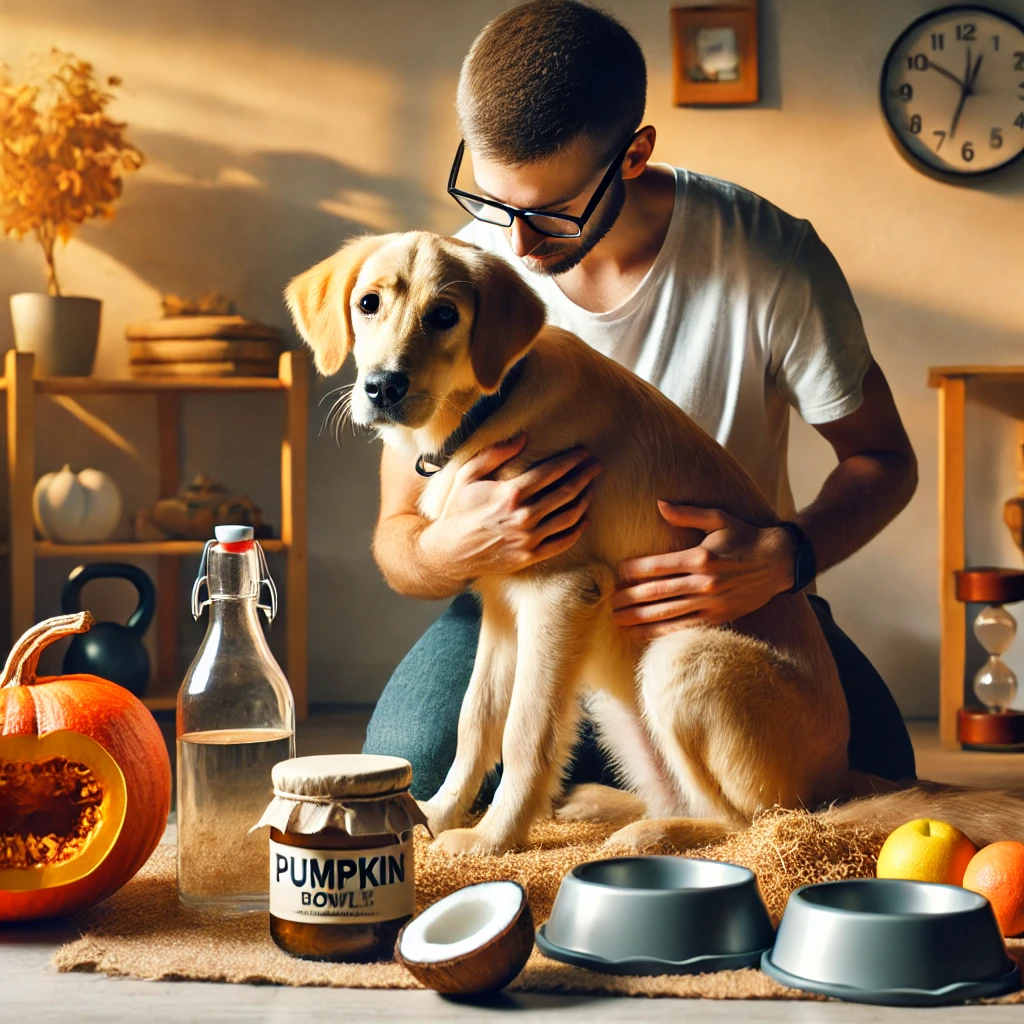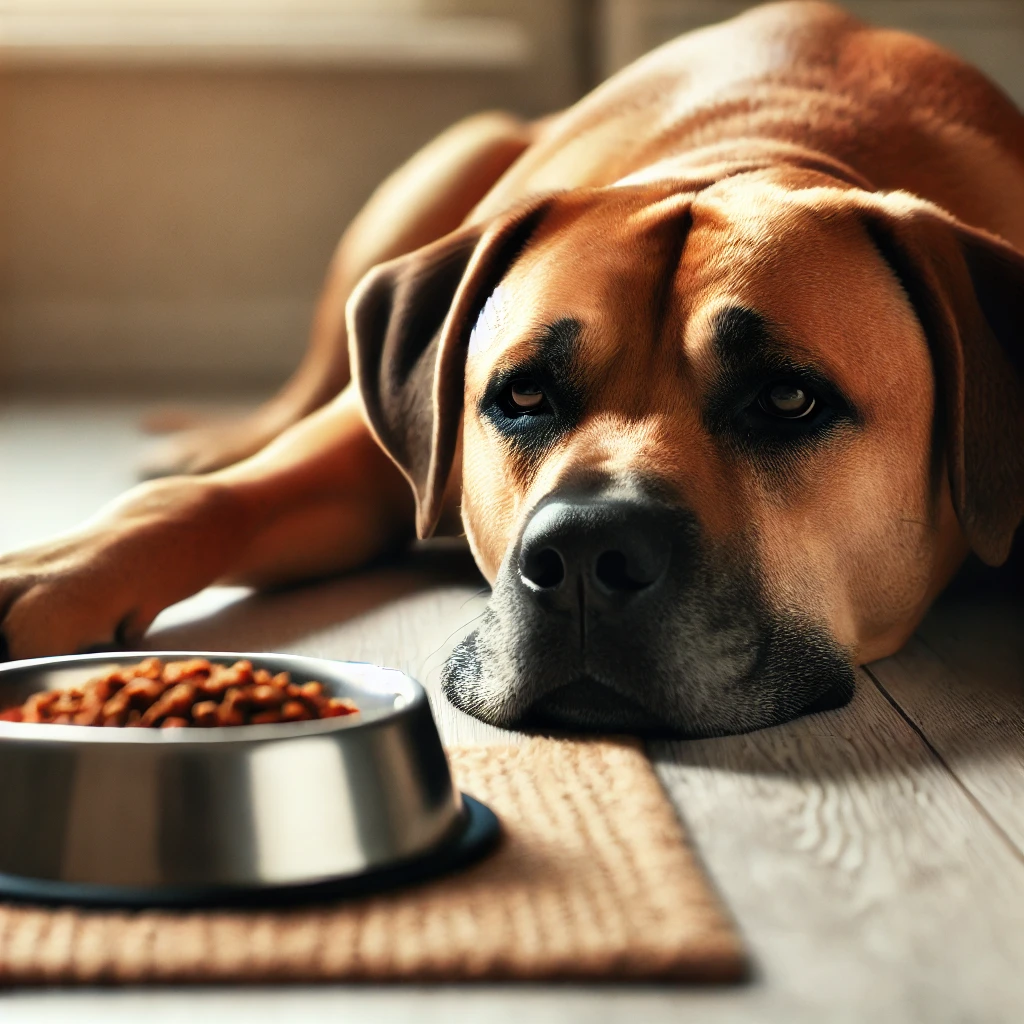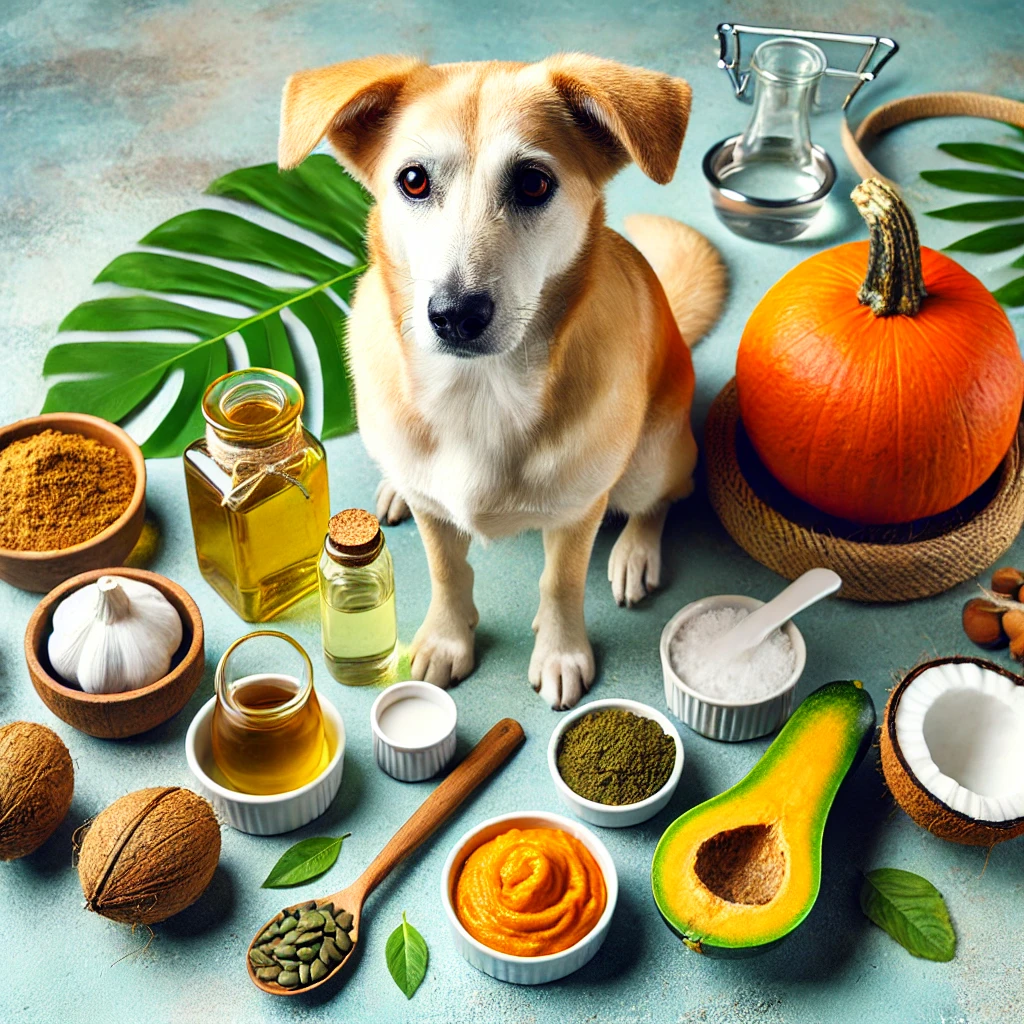
Here is a real-life style image showcasing how to make a constipated dog poop quickly.
The scene features natural remedies such as pumpkin puree, olive oil, coconut oil, fresh water, and a leash for exercise, all set in a calm and hopeful atmosphere.
Constipation is not only distressing for your dog but can also lead to serious health complications if left untreated.
Fortunately, there are natural solutions to help your furry friend find relief fast.
In this post, we’ll cover vet-approved, natural remedies to help make a constipated dog poop quickly and highlight helpful products available on Amazon for added convenience.
Signs Your Dog is Constipated
Constipation in dogs is more than just missing a bowel movement; it’s often accompanied by other symptoms that can be easily spotted if you know what to look for.
Below are the key signs of constipation, with additional details to help you identify the issue early and take action.
1. Straining or Pain During Defecation
One of the most common signs of constipation is when your dog repeatedly attempts to defecate but struggles to pass stool.
You might notice your dog:
- Hunching over and straining to poop without producing much (or any) stool.
- Whimpering, yelping, or showing signs of pain during the effort.
- Squatting frequently but without any success, indicating discomfort or difficulty.
2. Hardened, Dry Stools
If your dog does manage to pass stool, it will often be very hard, dry, and pellet-like in appearance.
This type of stool is a classic indication of dehydration or a lack of fiber in the diet.
- Normal stools are soft but firm, whereas constipated stools may be small, round, or even crumble upon contact due to dryness.
3. No Defecation for Over 48 Hours
A healthy dog should typically defecate at least once or twice daily, depending on their diet and activity levels. I
f your dog hasn’t had a bowel movement in over 48 hours, it’s a clear sign of constipation.
- While occasional delays in bowel movements can happen, a consistent lack of defecation, especially paired with other symptoms, is a strong sign that your dog is constipated and in need of relief.
4. Lethargy and Decreased Appetite

Constipation can make your dog feel sluggish or tired due to the discomfort in their digestive tract.
This lethargy may manifest as:
- Reluctance to go on walks or play.
- Spending more time resting or lying down than usual.
In some cases, dogs with constipation might refuse food or eat less than they usually would.
The discomfort in their abdomen can make them feel full or nauseous, even though they haven’t properly digested their last meal.
5. Bloated or Swollen Abdomen
A constipated dog may exhibit visible bloating or swelling in their abdominal area due to the buildup of gas and stool in the digestive tract.
Gently feeling your dog’s stomach can reveal tenderness or a firm, distended abdomen, which is a sign that your dog’s digestive system is backed up.
6. Excessive Scooting or Licking Around the Anus
Dogs often try to relieve themselves of discomfort by scooting their bottom along the ground or licking excessively around their anal area.
While scooting is more commonly associated with anal gland issues, it can also occur when a dog is constipated and trying to stimulate the passage of stool.
7. Passing Mucus Without Stool
Sometimes, a constipated dog may strain and only pass a small amount of mucus without any stool.
The body may produce this mucus as a response to irritation in the colon caused by the lack of stool movement.
It’s a telltale sign of gastrointestinal distress.
8. Vomiting
In severe cases of constipation, particularly when a blockage is involved, the dog may vomit due to the pressure in their digestive system.
Vomiting can occur when the system is backed up, and the body can no longer process food properly.
If your dog is vomiting and constipated, it’s time to seek immediate veterinary help.
9. Unusual Posture or Painful Movements
You may notice that your dog is walking or standing differently.
Due to abdominal discomfort, a constipated dog might:
- Arch their back when standing or walking to relieve pressure on the abdomen.
- Seem stiff or hesitant to lie down due to the discomfort of bloating.
- Appear restless, as they are unable to find a comfortable position.
Recognizing these signs early is key to ensuring your dog gets the relief they need quickly.
If you spot any combination of these symptoms, you should begin with natural remedies to help relieve constipation.
However, if these signs persist or worsen, contact your vet for professional care to prevent further complications.
Understanding these symptoms can help you act swiftly to bring relief to your pet.
Causes of Dog Constipation

Understanding the causes of dog constipation is crucial to both preventing and treating this uncomfortable condition.
Constipation can stem from a variety of factors, ranging from diet and hydration issues to underlying medical conditions.
By identifying the root cause, you can address the issue effectively and prevent future bouts of constipation in your dog.
Here’s a detailed breakdown of the most common causes of dog constipation.
1. Diet-Related Causes
- Lack of Fiber: A common cause of constipation in dogs is a diet that is too low in fiber. Fiber is essential for healthy digestion because it helps move waste through the intestines by bulking up the stool and making it easier to pass. If your dog’s food lacks fiber, their stool may become too hard and difficult to expel.
- Solution: You can add fiber to your dog’s diet by incorporating foods like pumpkin puree or opting for high-fiber dog food formulas.
- Dehydration: Without enough water in your dog’s system, the colon absorbs more water from the waste material, making the stool dry, hard, and difficult to pass. Dehydration can occur due to insufficient water intake, excessive exercise without replenishing fluids, or underlying medical conditions.
- Solution: Ensure your dog always has access to fresh water and encourage hydration, especially during hot weather or after physical activity.
- Indigestible Items: Dogs sometimes eat things they shouldn’t, like bones, toys, rocks, or even grass. These indigestible objects can obstruct the intestines, causing constipation or, in more serious cases, a complete blockage. This is more common in dogs that chew aggressively or have access to non-food objects around the house or yard.
- Solution: Monitor your dog’s environment and remove any small objects that they could swallow. Also, provide chew toys or bones that are safe for their size and breed.
- Sudden Dietary Changes: Abruptly changing your dog’s food can upset their digestive system. Moving from one type of dog food to another, or switching from a wet to dry diet, can lead to constipation as your dog’s gut adapts to the new food.
- Solution: Transition your dog’s diet slowly over a week or more to give their digestive system time to adjust.
2. Lifestyle Causes
- Lack of Exercise: Dogs, like humans, need regular physical activity to keep their digestive system functioning properly. A sedentary lifestyle can lead to a slower digestive process and, eventually, constipation. Older dogs or dogs that are kept indoors for long periods without regular walks or playtime are more likely to experience constipation.
- Solution: Ensure your dog gets daily exercise suited to their breed and energy level. Even a short walk can help stimulate bowel movements.
- Obesity: Overweight dogs tend to have a slower metabolism and digestive process, leading to a higher risk of constipation. In some cases, excess weight can cause mechanical blockages where the abdomen presses against the intestines, further complicating digestion.
- Solution: Maintain your dog’s ideal weight through a balanced diet and regular exercise. If your dog is overweight, consult your vet for a tailored weight-loss plan.
- Stress or Anxiety: Just like people, dogs can suffer from stress-induced digestive problems. Major changes, such as moving to a new home, separation anxiety, or changes in routine, can disrupt your dog’s normal bowel movements and lead to constipation.
- Solution: Keep your dog’s routine as consistent as possible and address any sources of anxiety. Introducing calming activities or supplements can also help reduce stress.
3. Medical Causes
- Anal Gland Problems: The anal glands in dogs help with the passage of stool by secreting fluid during defecation. If these glands become impacted or infected, they can cause pain and discomfort when trying to poop, leading to constipation. Your dog may also scoot their rear on the ground or lick excessively around their anal area.
- Solution: Regularly express your dog’s anal glands, either at home (if you’re comfortable) or by having a vet or groomer do it.
- Intestinal Blockages: A more serious cause of constipation is a blockage in the intestines, which can be caused by ingested foreign objects (like toys or bones) or a buildup of hair or feces. This condition can lead to severe discomfort and may require surgery to resolve.
- Solution: If your dog hasn’t passed stool for several days and shows signs of pain or vomiting, seek veterinary help immediately.
- Neurological Disorders: Conditions affecting the nerves or muscles responsible for bowel movements can cause constipation in dogs. Spinal injuries, nerve damage, or degenerative diseases may interfere with a dog’s ability to defecate properly.
- Solution: If you suspect a neurological issue, consult your vet. They may recommend physical therapy or other treatments to help stimulate bowel movements.
- Medications: Certain medications, such as opioids, antacids, and antihistamines, can cause constipation as a side effect. If your dog is taking any medication, constipation may be a temporary side effect.
- Solution: Speak to your vet about adjusting the dosage or prescribing a stool softener if necessary.
- Hypothyroidism: Dogs with hypothyroidism, a condition where the thyroid gland doesn’t produce enough hormones, may experience slower metabolism and digestion, leading to constipation.
- Solution: If your dog has other signs of hypothyroidism (such as weight gain, lethargy, or dry skin), a vet can run tests and prescribe hormone supplements to regulate the condition.
- Arthritis or Joint Pain: Dogs with arthritis or other forms of joint pain may avoid squatting or straining due to the discomfort it causes, leading to constipation. This is especially common in older dogs.
- Solution: Providing pain relief or anti-inflammatory medications can help your dog move more comfortably and maintain regular bowel movements.
4. Aging and Constipation
Older dogs are more prone to constipation due to several factors:
- Slower Digestion: As dogs age, their metabolism slows down, and so does their digestive process. This can cause waste to move more slowly through the intestines, resulting in hard, dry stools.
- Decreased Mobility: Older dogs are often less active, and this lack of movement can contribute to constipation.
- Underlying Health Conditions: Senior dogs are more likely to suffer from conditions like arthritis, hypothyroidism, or neurological disorders that can affect bowel movements.
- Solution: Ensure older dogs get moderate exercise, maintain a fiber-rich diet, and receive routine vet checkups to address any underlying health issues that could lead to constipation.
By understanding the various causes of constipation in dogs, you can take preventative measures to maintain your dog’s digestive health and act quickly if constipation occurs.
Whether it’s adjusting their diet, increasing their activity, or seeking veterinary care, recognizing the cause is key to keeping your dog comfortable and healthy.g.
Natural Solutions to Help Your Dog Poop Quickly

Luckily, there are several natural remedies and helpful products that can aid in relieving your dog’s constipation.
Here’s how to make a constipated dog poop quickly using safe, at-home solutions:
1. Increase Fiber Intake
Fiber is key to keeping things moving in your dog’s digestive system.
Adding fiber-rich foods and supplements to their diet can help soften the stool and promote bowel movements.
- Pumpkin Puree: A few tablespoons of plain, canned pumpkin (not the pie filling) can work wonders. Pumpkin is a great source of fiber and moisture, helping to bulk up stools and make them easier to pass.
Product Suggestion: Libby’s 100% Pure Pumpkin
- Psyllium Husk: This natural fiber supplement can be mixed into your dog’s food. Start with a small amount and adjust based on results.
Product Suggestion: NOW Supplements, Psyllium Husk Powder
2. Hydration is Key
Dehydration is a common cause of constipation. Make sure your dog is drinking enough water to prevent hard, dry stools.
- Encourage Drinking: If your dog isn’t drinking much, try adding water to their food or offering ice cubes as a fun way to hydrate.
- Broth Additions: Adding low-sodium chicken or beef broth to your dog’s water bowl can make it more appealing and increase their fluid intake.
Product Suggestion: Pacific Foods Organic Low Sodium Chicken Broth
3. Exercise for Digestion
Physical activity stimulates the digestive system and can help relieve constipation.
- Daily Walks: Even a short walk around the neighborhood can stimulate digestion and encourage a bowel movement.
- Playtime: Engaging your dog in active play can also get their system moving, whether it’s fetch or a quick game of tug.
Product Suggestion: Chuckit! Ultra Ball Dog Toy
4. Natural Oils
Some oils can help lubricate your dog’s digestive tract, making it easier for them to pass stool.
- Olive Oil or Coconut Oil: Add a teaspoon of olive oil or coconut oil to your dog’s food. These oils act as natural lubricants, promoting bowel movement. Start with small doses to avoid diarrhea.
Product Suggestion: Viva Naturals Organic Extra Virgin Coconut Oil
5. Massage and Belly Rubs
A gentle belly rub or massage can help stimulate your dog’s intestines and encourage a bowel movement.
- How to Massage: Use circular motions on your dog’s belly, working your way from the ribs down to the lower abdomen. This gentle pressure can help stimulate their digestive tract.
Product Suggestion: Consider using a pet-safe massage tool like the Furbliss Pet Brush and Massage Tool
When to Seek Veterinary Help
While natural remedies are often effective, there are times when constipation requires professional attention. Contact your vet if:
- Your dog hasn’t had a bowel movement in more than 48 hours despite home remedies.
- You notice signs of severe discomfort, vomiting, or bloating.
- There is blood in the stool, or your dog is straining without passing anything.
These could be signs of a more serious issue, such as an intestinal blockage, that needs medical intervention.
Prevention Tips to Keep Your Dog’s Digestive System Healthy
Prevention is always better than cure. Here are some simple ways to keep your dog’s digestion on track and avoid future bouts of constipation:
1. Balanced Diet
Make sure your dog’s diet includes plenty of fiber from sources like vegetables or specialized dog food formulas. A balanced diet helps regulate bowel movements.
Product Suggestion: Hill’s Science Diet Dry Dog Food, Perfect Digestion
2. Regular Exercise
Encourage daily exercise, whether it’s a walk, playtime, or running around the yard. Physical activity keeps digestion flowing smoothly.
3. Hydration
Always provide fresh water and encourage your dog to drink throughout the day. Proper hydration is critical for maintaining soft stools and easy bowel movements.
Product Suggestion: PetSafe Drinkwell Water Fountain
4. Routine Vet Visits
Regular vet check-ups ensure that any underlying health issues are addressed before they lead to constipation.
Your vet can also recommend any necessary dietary or lifestyle adjustments.
Conclusion
Constipation can be uncomfortable and stressful for both you and your dog.
Fortunately, natural remedies like fiber, hydration, exercise, and natural oils can help get your dog’s digestive system back on track.
Using products like pumpkin puree, coconut oil, and pet-safe broth can make these remedies even more effective.
If you notice signs of constipation, act quickly using these safe and effective solutions.
And remember, if symptoms persist, don’t hesitate to contact your vet for professional advice.
Has your dog experienced constipation?
What worked best for them?
Share your experiences in the comments below, and if you found this post helpful, don’t forget to share it with other dog parents!
Learn More:
Salmon Oil for Dogs: 7 Amazing Benefits Every Pet Parent Should Know
How to Treat Dog Ear Infection Without Vet: 7 Proven Home Remedies
As an Amazon Associate I earn from qualifying purchases.


